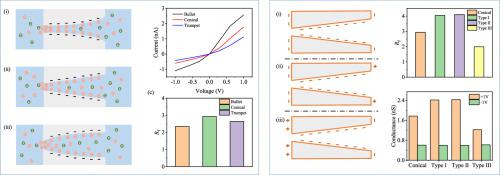International Journal of Heat and Mass Transfer ( IF 5.0 ) Pub Date : 2023-03-12 , DOI: 10.1016/j.ijheatmasstransfer.2023.124038 Nan Qiao , Zhe Zhang , Zheng Liu , Wei Lu , Changzheng Li

|
Ion current rectification (ICR) in nanochannels has attracted increasing attention for its great potential in the applications of ionic circuits and biological sensors. Herein, the influence of nanochannel shape and surface charge on the ion transport and ICR performance of asymmetric nanochannels was numerically investigated. Firstly, three asymmetric nanochannels with different shapes (bullet, conical, and trumpet) were constructed to investigate the spatial size effect on the ICR behavior. And then selected the best-performing one to further analyze the effect of the surface charge on the ICR. In the investigation of spatial size effect, it is found that the increases and the decreases of spatial size will not be beneficial for improving the ICR performance and the conical nanochannel exhibits the best performance. In the investigation of surface charge effect, it is found that specified asymmetric surface charge on the outer wall surface enhances the corresponding ICR performance, revealing the cooperative role with inner wall surface charge. Besides, it is found that the outer wall surface charge is dominant when the nanochannel length is small and the inner wall surface charge is dominant when the nanochannel length is large. Moreover, the finite length enhancement effect for ICR performance is illustrated by tuning the range of outer wall surface charged zone, indicating the charged zone near the entrance and exit plays the dominant role on ion transport. The obtained results provide essential insights on the ion transport and useful guidelines for the design and performance optimization of biological sensors and nanofluidic devices.
中文翻译:

不对称纳米通道中的离子电流整流:纳米通道形状和表面电荷的影响
纳米通道中的离子电流整流(ICR)因其在离子电路和生物传感器应用中的巨大潜力而受到越来越多的关注。在此,数值研究了纳米通道形状和表面电荷对不对称纳米通道的离子传输和 ICR 性能的影响。首先,构建了三个不同形状(子弹形、圆锥形和喇叭形)的非对称纳米通道,以研究空间尺寸对 ICR 行为的影响。然后选择性能最好的一个进一步分析表面电荷对ICR的影响。在空间尺寸效应的研究中,发现空间尺寸的增加和减小都不利于提高ICR性能,锥形纳米通道表现出最好的性能。在表面电荷效应的研究中,发现外壁表面指定的不对称表面电荷增强了相应的ICR性能,揭示了与内壁表面电荷的协同作用。此外,发现当纳米通道长度小时,外壁表面电荷占主导地位,而当纳米通道长度较大时,内壁表面电荷占主导地位。此外,通过调整外壁表面带电区的范围说明了对ICR性能的有限长度增强效应,表明入口和出口附近的带电区对离子传输起着主导作用。获得的结果为离子传输提供了重要的见解,并为生物传感器和纳米流体设备的设计和性能优化提供了有用的指导。发现外壁表面指定的不对称表面电荷增强了相应的 ICR 性能,揭示了与内壁表面电荷的协同作用。此外,发现当纳米通道长度小时,外壁表面电荷占主导地位,而当纳米通道长度较大时,内壁表面电荷占主导地位。此外,通过调整外壁表面带电区的范围说明了对ICR性能的有限长度增强效应,表明入口和出口附近的带电区对离子传输起着主导作用。获得的结果为离子传输提供了重要的见解,并为生物传感器和纳米流体设备的设计和性能优化提供了有用的指导。发现外壁表面指定的不对称表面电荷增强了相应的 ICR 性能,揭示了与内壁表面电荷的协同作用。此外,发现当纳米通道长度小时,外壁表面电荷占主导地位,而当纳米通道长度较大时,内壁表面电荷占主导地位。此外,通过调整外壁表面带电区的范围说明了对ICR性能的有限长度增强效应,表明入口和出口附近的带电区对离子传输起着主导作用。获得的结果为离子传输提供了重要的见解,并为生物传感器和纳米流体设备的设计和性能优化提供了有用的指导。









































 京公网安备 11010802027423号
京公网安备 11010802027423号